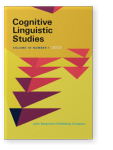Vol. 10:1 (2023) ► pp.199–226
Responsive strategies and self-identity construction in “Versailles Humblebragging” on Chinese social media
Versailles humblebragging is becoming an increasingly pervasive pragmatic and linguistic phenomenon since late 2020 in face-to-face and social media communication in China. Despite its ubiquity, there is a relative paucity of empirical research on this new phenomenon, particularly on the reactions of followers in the digital communicative context and the self-identities constructed by the posters, as well as the theoretical limitations to explicate the social cognitive factors behind the novel pragmatic behavior. This study integrated pragmatic and social cognitive theories to conduct quantitative and qualitative analyses of the responsive strategies followers used and the self-identity the humblebraggers built in this phenomenon. Based on the data retrieved from Chinese social media Weibo, we have found generally two major types of responsive strategies, namely the explicit and implicit. A majority of followers employed the implicit strategies to express their acceptance and liking with a preponderance of clicking the “like” affordance, suggesting that Versailles humblebragging helps to build good interpersonal relationship on Weibo. We have also identified seven types of self-identities and explored the underlying factors from the perspective of social cognition. It might be concluded from the findings that certain social and cultural shared beliefs, values and patterns of life are potent factors in shaping Chinese posters’ interpretation of themselves and other people.
Article outline
- 1.Introduction
- 2.Self-praise and Versailles humblebragging
- 2.1Self-praise in face-to-face communication and social networking sites
- 2.2Versailles humblebragging
- 3.Social cognition, self-concept and self-identity
- 4.Methodology
- 5.Results and discussion
- 5.1The results of responsive strategies
- 5.1.1Explicit response of acceptance
- 5.1.2Explicit response of rejection
- 5.1.3Explicit Response of Evading
- 5.1.4Implicit self-praise response
- 5.2The results of constructed self-identities
- 5.3Discussion
- 5.1The results of responsive strategies
- 6.Conclusion
-
References
